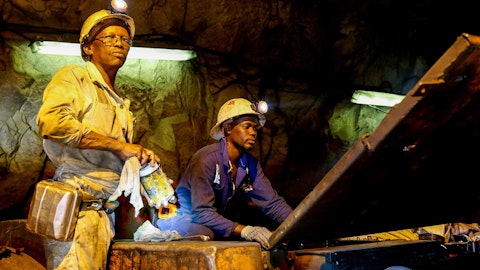Russell Lawlar: The other thing, you’ll see this in the technical report, but the payback on those pits, the Prince Paul [ph] and the West Vine Crampillar Pit [ph], comes very, very quickly in the early 2030s. So that investment period of ’28, ‘29 and then a little bit into 2030 gets paid back quickly in ’31, ‘32, etc. So that speaks to what Phil just said in terms of us already – today we’re investing in the surface fleet, etc., setting ourselves up for this mine for the long run.
Joseph Reagor: Okay. And one final thing, if I could. I saw an article a couple of weeks ago. Phil, I believe you made the comment that you guys are looking at South America as an opportunity to maybe expand the company and the production profile. Is this something that’s a long-term thought or is there any potential to do M&A in the next year or two?
Phillips Baker: Well, there is always the potential Joe to do it. What we have said consistently is we are prepared to go outside the United States and Canada for silver assets. We won’t do that for gold or any other metal, but we will consider it for silver. Having said that, the ability to do those transactions are difficult. And so we are not going to – we don’t have to push it. We’re fortunate in that we have growth in the near term. We should get to close to 20 million ounces by 2026. We have in our portfolio, we actually have – to include the operating properties, we have 20 properties in our portfolio, half of which are silver assets, half of which are gold assets, and we’d like to advance those. Some of them are sort of in the permitting process.
Some we need to do more exploration on, but we do have the ability to do things within our portfolio. But having said that, our long-term objective is to be really the premier silver company, which means more production, as well as become – and this is a super long-term goal, but as well as become an S&P 500 company. And we think with more production and higher prices, which we’re as I indicated, why we think we’ll see higher prices. We think that that’s something that could be achieved in the long term.
Joseph Reagor: Okay. Thanks for the color. I’ll turn it over.
Phillips Baker: Sure thing.
Operator: Your next question comes from Don DeMarco with National Bank Financial. Your line is open.
Don DeMarco : Thank you, operator. Good morning, Phil. My first question, maybe just building on the last caller’s question about M&A, we’ve seen – with regard to pursuing silver assets, we’ve seen some of your peers challenge to add silver assets to diversify into gold. I think I heard from you that you’re still – your priority silver. You wouldn’t certainly go for gold outside of North America. But would you consider gold assets, or are you still firmly focused in any M&A, if it met all your hurdles, primarily focused on silver?
Phillips Baker: We’re absolutely primarily focused on silver. We will however consider gold and maybe even other metals that are in the jurisdictions, in the places that we operate. So we’re in Alaska, we’re in Yukon, we’re in Idaho, we’re in the Abitibi, Quebec, and I would characterize just across the border geologically as being the same. So would we consider things other than silver in those places? The answer is yes. Is it our first priority? No, but we certainly think – you saw the ATAC transaction that we did in the Yukon. We think that, it was a strategic acquisition that really sets up Hecla for a very long-term potential of things that could be very, very meaningful. So we are prepared to consider those things.
Don DeMarco : Okay. Yeah, it makes sense, looking at potential jurisdiction synergies. Looking at the production outlook, we see that silver production is increasing over the next three years. We see 20 million ounces at the high end of the range in a few years. Costs weren’t included, we get that, but how should we think about costs over this timeframe? Should we think about costs increasing or flat? Is there any – just kind of for the sake of modeling, what trends should we think about?
Phillips Baker: I would generally say that you’ll have some inflationary pressure, so you’ll see costs increase as a result of that. I’m going to talk about first in terms of the quantum of costs, rather than on a unit basis. You’ll see some slight increases, but nothing at Greens Creek and the Lucky Friday. I’m not anticipating any sort of significant sort of cost increase. And at Keno, it will be in a transitional period. I think Keno will – the objective we will probably have long term given the exploration results we have is to see that property increase its throughput. We, in fact in the technical report, have an assumption that we get to 550 tons or 600 short tons per day in three or four years from now. So as a result, you’ll see more dollars needing to be spent at that location.
But then when you look at it on a unit basis, for Greens Creek and the Lucky Friday, it’s really going to be a function of the byproducts and the prices of those byproducts. To the extent we’re at the similar sort of price levels that we are now, I wouldn’t anticipate much of a change. For Keno, I think over time we will be able to drive the cost down pretty substantially. But it’s going to take more times. And I think trying to get some of these synergies with Greens Creek, I think could be a benefit to both properties. Anything to add, Russell?





